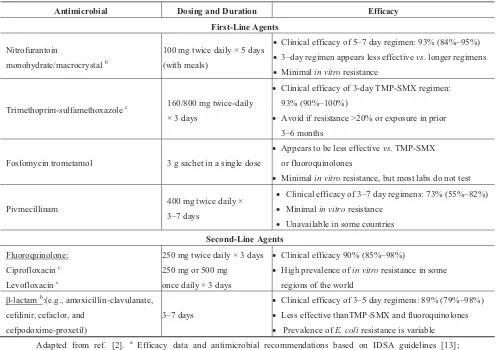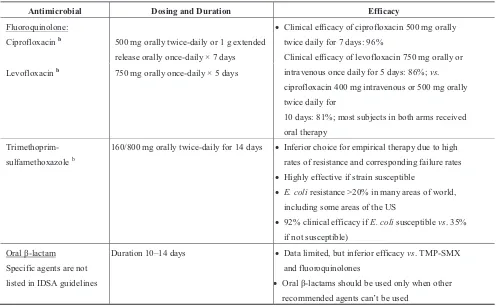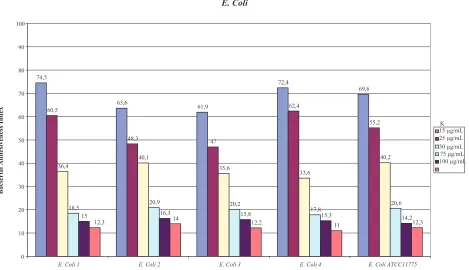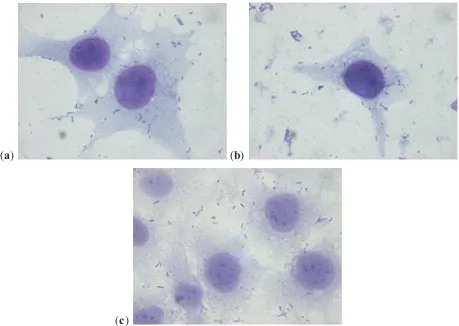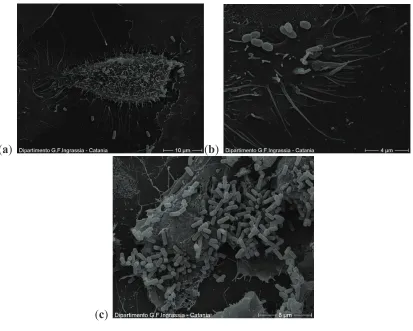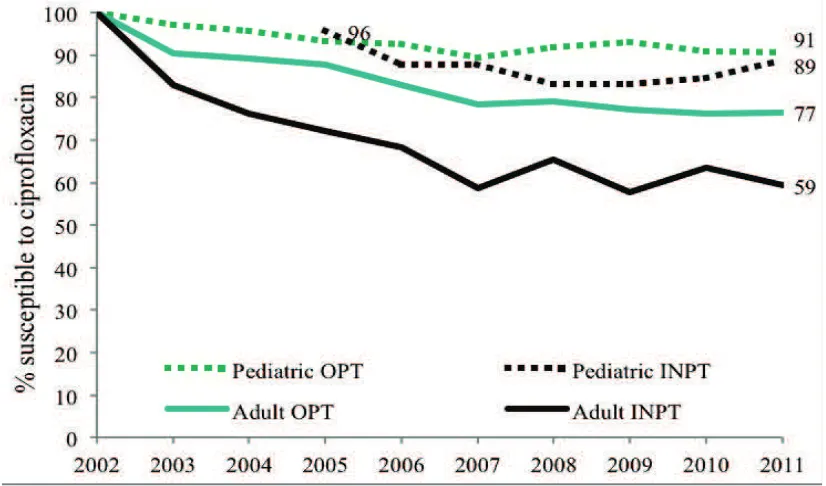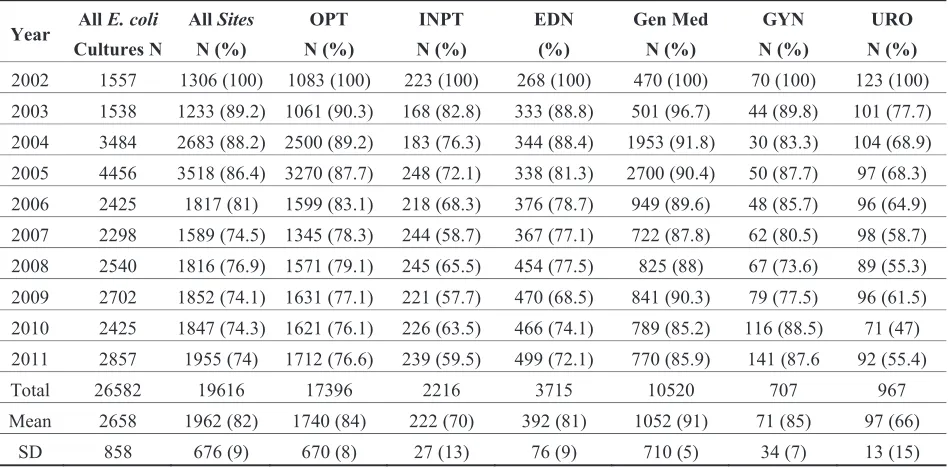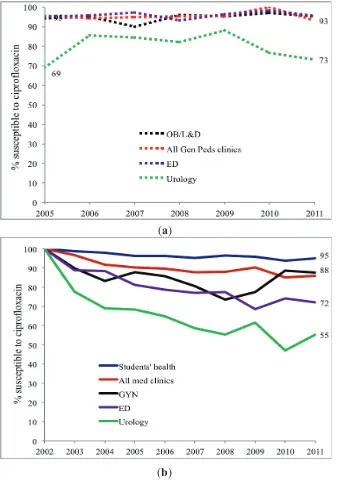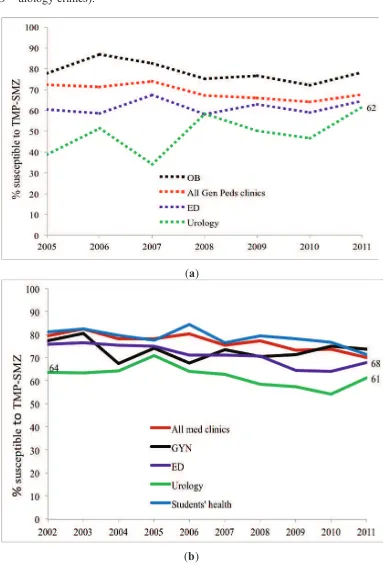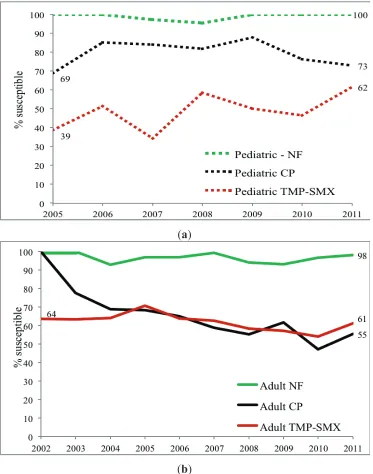Printed Edition of the Special Issue Published in Antibiotics Edited by
Truls E. Bjerklund Johansen and Kurt G. Naber
Antibiotics (ISSN 2079-6382)in 2014 (available at:
http://www.mdpi.com/journal/antibiotics/special_issues/urinary-tract-infections).
Guest Editors
Truls E. Bjerklund Johansen
Department of Urology, Oslo University Hospital Oslo, Norway
Kurt G. Naber
Technical University of Munich Munich, Germany
Editorial Office
MDPI AG
Klybeckstrasse 64 Basel, Switzerland
Publisher
Shu-Kun Lin
Production Editor
Martyn Rittman
1. Edition 2015
MDPI • Basel • Beijing • Wuhan
ISBN 978-3-906980-80-5
Table of Contents
List of Contributors ... V
Editorial
Truls E. Bjerklund Johansen and Kurt G. Naber
Urinary Tract Infections
Antibiotics2014, 3(3), 375-377; doi:10.3390/antibiotics3030375 ... VIII http://www.mdpi.com/2079-6382/3/3/375
Chapter 1
Lilian M. Abbo and Thomas M. Hooton
Antimicrobial Stewardship and Urinary Tract Infections
Antibiotics2014, 3(2), 174-192; doi:10.3390/antibiotics3020174 ... 1 http://www.mdpi.com/2079-6382/3/2/174
Chapter 2
Daria Nicolosi, Gianna Tempera, Carlo Genovese and Pio M. Furneri
Anti-Adhesion Activity of A2-type Proanthocyanidins (a Cranberry Major Component) on Uropathogenic E. coli and P. mirabilis Strains
Antibiotics2014, 3(2), 143-154; doi:10.3390/antibiotics3020143 ... 20 http://www.mdpi.com/2079-6382/3/2/143
Chapter 3
Bernd Wiedemann, Anke Heisig and Peter Heisig
Uncomplicated Urinary Tract Infections and Antibiotic Resistance—Epidemiological and Mechanistic Aspects
Antibiotics2014, 3(3), 341-352; doi:10.3390/antibiotics3030341 ... 31 http://www.mdpi.com/2079-6382/3/3/341
Chapter 4
Marcelo Hisano, Homero Bruschini, Antonio Carlos Nicodemo and Miguel Srougi
Uncomplicated Urinary Tract Infections in Women in a Sao Paulo Quaternary Care Hospital: Bacterial Spectrum and Susceptibility Patterns
Antibiotics2014, 3(1), 98-108; doi:10.3390/antibiotics3010098 ... 43 http://www.mdpi.com/2079-6382/3/1/98
Chapter 5
Winifred Owumi, Niaz Banaei and Linda D. Shortliffe
Adult and Pediatric Intra-Institutional Trends of Ciprofloxacin Susceptibility in E. coli Positive Urinary Cultures
Antibiotics2014, 3(2), 163-173; doi:10.3390/antibiotics3020163 ... 53 http://www.mdpi.com/2079-6382/3/2/163
Chapter 6
Ceire Costelloe, O. Martin Williams, Alan A. Montgomery, Colin Dayan and Alastair D. Hay
Antibiotic Prescribing in Primary Care and Antimicrobial Resistance in Patients Admitted to Hospital with Urinary Tract Infection: A Controlled Observational Pilot Study
Chapter 7
Franck Bruyère, Joseph-Alain Ruimy, Louis Bernard, Raphael Elfassi, Olivier Boyer, Fabrice Amann and Paul Meria
Value of Provoked or Spontaneous Flank Pain in Men with Febrile Urinary Tract Infections
Antibiotics2014, 3(2), 155-162; doi:10.3390/antibiotics3020155 ... 74 http://www.mdpi.com/2079-6382/3/2/155
Chapter 8
Satoshi Takahashi, Hiroshi Kiyota, Shin Ito, Akihiko Iwasawa, Yoshiki Hiyama, Teruhisa Uehara, Koji Ichihara, Jiro Hashimoto, Naoya Masumori, Kenichi Sunaoshi, Koichi Takeda, Nobukazu Suzuki, Takahide Hosobe, Hirokazu Goto, Hidenori Suzuki and Shoichi Onodera
Clinical Efficacy of a Single Two Gram Dose of Azithromycin Extended Release for Male Patients with Urethritis
Antibiotics2014, 3(2), 109-120; doi:10.3390/antibiotics3020109 ... 81 http://www.mdpi.com/2079-6382/3/2/109
Chapter 9
Joey Lo, Dirk Lange and Ben H. Chew
Ureteral Stents and Foley Catheters-Associated Urinary Tract Infections: The Role of Coatings and Materials in Infection Prevention
Antibiotics2014, 3(1), 87-97; doi:10.3390/antibiotics3010087 ... 93 http://www.mdpi.com/2079-6382/3/1/87
Chapter 10
Walid Elkhatib and Ayman Noreddin
In Vitro Antibiofilm Efficacies of Different Antibiotic Combinations with Zinc Sulfate against Pseudomonas aeruginosa Recovered from Hospitalized Patients with Urinary Tract Infection
Antibiotics2014, 3(1), 64-84; doi:10.3390/antibiotics3010064 ... 104 http://www.mdpi.com/2079-6382/3/1/64
Chapter 11
Maria Jose Munoz-Davila
Role of Old Antibiotics in the Era of Antibiotic Resistance. Highlighted Nitrofurantoin for the Treatment of Lower Urinary Tract Infections
Antibiotics2014, 3(1), 39-48; doi:10.3390/antibiotics3010039 ... 125 http://www.mdpi.com/2079-6382/3/1/39
Chapter 12
Ekaterina Kulchavenya, Irina Felker and Elena Brizhatyuk
International Conference “Urogenital Infections and Tuberculosis” in Novosibirsk, Russia, Has Opened New Perspectives in the Fight against Tuberculosis
List of Contributors
Fabrice Amann: General Practitioner, 15 rue Jean Baptiste Berlier, Paris 75013, France
Niaz Banaei: Departments of Pathology and Medicine, Stanford University Medical Center, 300
Pasteur Drive, Stanford, CA 94304, USA
Louis Bernard: University Francois Rabelais de Tours, PRES Centre Val de Loire Université,
Tours 37000, France; Infectious Disease Department, University Hospital of Tours, Loire Valley
37044, France
Olivier Boyer: General Practitioner, 15 rue Jean Baptiste Berlier, Paris 75013, France
Elena Brizhatyuk: Novosibirsk Research Institute for Tuberculosis, Novosibirsk 630040, Russia
Homero Bruschini: Division of Urology, Hospital das Clinicas-SP, University of Sao Paulo, 255
Doutor Enéas Carvalho de Aguiar Ave., 7th floor, São Paulo 05403-000, Brazil
Franck Bruyère: Urology Department, University Hospital of Tours, Loire Valley 37044, France;
University Francois Rabelais de Tours, PRES Centre Val de Loire Université, Tours 37000, France
Ben H. Chew: Department of Urologic Sciences, University of British Columbia, 2660 Oak Street,
Vancouver, BC, V6H 3Z6, Canada
Ceire Costelloe: Centre for Primary Care and Public health, Blizzard Institute, Queen Mary
University of London, London E1 2AB, UK
Colin Dayan: Institute of Molecular & Experimental Medicine, Cardiff University School of
Medicine, Wales Heart Research Institute, Heath Park, Cardiff CF14 4XN, UK
Raphael Elfassi: General Practitioner, 15 rue Jean Baptiste Berlier, Paris 75013, France
Walid Elkhatib: Department of Microbiology and Immunology, Faculty of Pharmacy, Ain Shams
University, African Union Organization St. Abbassia, Cairo 11566, Egypt; Department of
Pharmacy Practice, School of Pharmacy, Hampton University, Kittrell Hall Hampton, Virginia
23668, USA
Irina Felker: Novosibirsk Research Institute for Tuberculosis, Novosibirsk 630040, Russia
Pio M. Furneri: Department of Biomedical Sciences, Section of Microbiology, University of
Catania, Via Androne 81, Catania 95124, Italy
Carlo Genovese: Department of Biomedical Sciences, Section of Microbiology, University of
Catania, Via Androne 81, Catania 95124, Italy
Hirokazu Goto: Department of Urology, Fuji City General Hospital, 50 Takashima-Cho, Fuji,
Jiro Hashimoto: Department of Urology, Sapporo Medical University School of Medicine, S. 1,
W. 16, Chuo-ku, Sapporo, Hokkaido 0608543, Japan
Alastair D. Hay: Centre for Academic Primary Care, NIHR School for Primary Care Research,
School of Social and Community Medicine, University of Bristol, Canynge Hall, Bristol BS8 2PS,
UK
Anke Heisig: Pharmaceutical Biology and Microbiology, Institute of Biochemistry and Molecular
Biology, University of Hamburg, Bundesstrasse 45, 20146 Hamburg, Germany
Peter Heisig: Pharmaceutical Biology and Microbiology, Institute of Biochemistry and Molecular
Biology, University of Hamburg, Bundesstrasse 45, 20146 Hamburg, Germany
Marcelo Hisano: Division of Urology, Hospital das Clinicas-SP, University of Sao Paulo, 255
Doutor Enéas Carvalho de Aguiar Ave., 7th floor, São Paulo 05403-000, Brazil
Yoshiki Hiyama: Department of Urology, Sapporo Medical University School of Medicine, S. 1,
W. 16, Chuo-ku, Sapporo, Hokkaido 0608543, Japan
Takahide Hosobe: Hosobe Clinic, 1-1-15, Nezu, Bunkyo-ku, Tokyo 1130031, Japan
Koji Ichihara: Department of Urology, Sapporo Medical University School of Medicine, S. 1, W.
16, Chuo-ku, Sapporo, Hokkaido 0608543, Japan
Shin Ito: iClinic, 5-9-6, Nagamachi, Taihaku-ku, Sendai, Miyagi 9820011, Japan
Akihiko Iwasawa: Iwasawa Clinic, Sapporo Medical University School of Medicine, S. 1, W. 16,
Chuo-ku, Sapporo, Hokkaido 0600061, Japan
Truls E. Bjerklund Johansen: Urology Department, Oslo University Hospital, 0424 Oslo,
Norway
Hiroshi Kiyota: Department of Urology, the Jikei University Katsushika Medical Center, 6-41-2
Aoto Katsushika-ku, Tokyo 1258506, Japan
Ekaterina Kulchavenya: Novosibirsk Research Institute for Tuberculosis, Novosibirsk 630040,
Russia; Novosibirsk State Medical University, Novosibirsk 630040, Russia
Dirk Lange: Department of Urologic Sciences, University of British Columbia, 2660 Oak Street,
Vancouver, BC, V6H 3Z6, Canada
Joey Lo: Department of Urologic Sciences, University of British Columbia, 2660 Oak Street,
Vancouver, BC, V6H 3Z6, Canada
Naoya Masumori: Department of Urology, Sapporo Medical University School of Medicine, S. 1,
W. 16, Chuo-ku, Sapporo, Hokkaido 0608543, Japan
Paul Meria: Urology Department, Saint Louis Hospital, Paris 75010, France
Alan A. Montgomery: Faculty of Medicine and Clinical Sciences, University of Nottingham,
Maria Jose Munoz-Davila: Microbiology laboratory, Rafael Méndez Hospital, Ctra. Nacional
340, Km. 589, Lorca, Murcia 30817, Spain
Kurt G. Naber: Urology Department, Technical University of Munich, Munich 81675, Germany
Antonio Carlos Nicodemo: Infectious Disease Department, Hospital das Clinicas-SP, University
of Sao Paulo, 255 Doutor Enéas Carvalho de Aguiar Ave., 4th floor, São Paulo 05403-000, Brazil
Daria Nicolosi: Department of Biomedical Sciences, Section of Microbiology, University of
Catania, Via Androne 81, Catania 95124, Italy
Ayman Noreddin: Department of Pharmacy Practice, School of Pharmacy, Hampton University,
Kittrell Hall Hampton, Virginia 23668, USA; Graduate Program of Biomedical Sciences, Eastern
Virginia Medical School, 825 Fairfax Ave, Norfolk, Virginia 23507, USA
Shoichi Onodera: Department of Urology, Fuji City General Hospital, 50 Takashima-Cho, Fuji,
Shizuoka 4178567, Japan
Winifred Owumi: Department of Urology, Stanford University Medical Center, 750 Welch Rd,
MC: 5725, Stanford, CA 94305-5725, USA
Joseph-Alain Ruimy: General Practitioner, 15 rue Jean Baptiste Berlier, Paris 75013, France
Linda D. Shortliffe: Department of Urology, Stanford University Medical Center, 750 Welch Rd,
MC: 5725, Stanford, CA 94305-5725, USA
Miguel Srougi: Division of Urology, Hospital das Clinicas-SP, University of Sao Paulo, 255
Doutor Enéas Carvalho de Aguiar Ave., 7th floor, São Paulo 05403-000, Brazil
Kenichi Sunaoshi: Teine Urologic Clinic, 1-12, Maeda 6-7, Teine-ku, Sapporo 0060816, Japan
Hidenori Suzuki: Department of Urology, Fuji City General Hospital, 50 Takashima-Cho, Fuji,
Shizuoka 4178567, Japan
Nobukazu Suzuki: Teine Urologic Clinic, 1-12, Maeda 6-7, Teine-ku, Sapporo 0060816, Japan
Satoshi Takahashi: Department of Urology, Sapporo Medical University School of Medicine, S.
1, W. 16, Chuo-ku, Sapporo, Hokkaido 0608543, Japan
Koichi Takeda: Teine Urologic Clinic, 1-12, Maeda 6-7, Teine-ku, Sapporo 0060816, Japan
Gianna Tempera: Department of Biomedical Sciences, Section of Microbiology, University of
Catania, Via Androne 81, Catania 95124, Italy
Teruhisa Uehara: Department of Urology, Sapporo Medical University School of Medicine, S. 1,
W. 16, Chuo-ku, Sapporo, Hokkaido 0608543, Japan
Bernd Wiedemann: Böstens Hoi 15, 24882 Schaalby, Germany
Owen M Williams: Health Protection Agency Microbiology Services, United Hospital Bristol
Editorial
Urinary Tract Infections
Truls E. Bjerklund Johansen and Kurt G. Naber
Reprinted from Antibiotics. Cite as: Johansen, T.E.B.; Naber, K.G. Urinary Tract Infections.
Antibiotics2014, 3, 375-377.
Urinary tract infections (UTI) are among the most frequently acquired infections in the community, but also in hospitals and other health care institutions, causing a huge amount of antibiotic consumption. During the last decade we have seen significant changes in the field of urinary tract infections regarding causative pathogens and antibiotic treatment calling for an update of current trends.
The worldwide increase of uropathogens resistant to former first line antibiotics, such as cotrimoxazole, fluoroquinolones and cephalosporins, has had detrimental consequences not only for treatment but also for prophylaxis of infectious complications after urological interventions. A paradigm shift concerning asymptomatic bacteriuria has had a great impact on the definition and management of UTIs today [1–4].
For uncomplicated lower UTI, such as acute cystitis in otherwise healthy women, not only a revival of old (oral) antibiotics, such as fosfomycin trometamol, pivmecillinam, nitrofurantoin, can be observed in many guidelines [5–7], but even a non-antimicrobial measure has been tested in a pilot study [8]. It will therefore be interesting to see the results of forthcoming phase III studies and whether antibiotic therapy could at least be partially replaced. For prophylaxis of recurrent episodes of uncomplicated UTI, non-antimicrobial measures are already preferred and antimicrobial prophylaxis is only recommended as a last resort [7].
However, for complicated, nosocomial and severe UTI including pyelonephritis, antibiotic therapy will still be a corner stone in combination with treatment of the underlying complicating conditions. Unfortunately, there are few new antimicrobial drugs in the pipelines of pharmaceutical companies with prospects to overcome the problem of multi and extended drug resistant uropathogens [9].
Although the classical distinction between uncomplicated and complicated UTI is still valid in principle, the different criteria to be considered are so heterogeneous, that a better (phenotypical) subclassification might be helpful, as proposed by the European Section of Infection of Urology (ESIU) of the European Association of Urology (EAU) [10].
Conflicts of Interest
The authors declare no conflict of interest.
References
1. Naber, K.G.; Schito, G.; Botto, H.; Palou, J.; Mazzei, T. Surveillance study in Europe and Brazil on clinical aspects and antimicrobial resistance epidemiology in females with cystitis (ARESC): Implications for empiric therapy. Eur. Urol.2008, 54, 1164–1178.
2. Tandogdu, Z.; Cek, M.; Wagenlehner, F.; Naber, K.; Tenke, P.; van Ostrum, E.; Bjerklund Johansen, T. Resistance patterns of nosocomial urinary tract infections in urology departments: 8-Year results of the global prevalence of infections in urology study. World J. Urol.
2014, 32, 791–801.
3. Wagenlehner, F.M.E.; van Oostrum, E.; Tenke, P.; Tandogdu, Z.; Cek, M.; Grabe, M.; Wullt, B.; Pickard, R.; Naber, K.G.; Pilatz, A.; et al. Infective complications after prostate biopsy: Outcome of the Global Prevalence Study of Infections in Urology (GPIU) 2010 and 2011. A prospective multinational multicentre prostate biopsy study. Eur. Urol.2013, 63, 521–527. 4. Wagenlehner, F.M.E.; Naber, K.G. Asymptomatic bacteriuria—Shift of paradigm.
Clin. Infect. Dis.2012, 55, 778–780.
5. Gupta, K.; Hooton, T.M.; Naber, K.G.; Wullt, B.; Colgan, R.; Miller, L.G.; Moran, G.J.; Nicolle, L.E.; Raz, R.; Schaeffer, A.J.; et al. International clinical practice guidelines for the treatment of acute uncomplicated cystitis and pyelonephritis in women: A 2010 update by the Infectious Diseases Society of America and the European Society for Microbiology and Infectious Diseases. Clin. Infect. Dis.2011, 52, e103–e120.
6. Wagenlehner, F.M.E.; Hoyme, U.; Kaase, M.; Fünfstück, R.; Naber, K.G.; Schmiemann, G. Clinical practice guidelines: Uncomplicated urinary tract infections. Dtsch. Arztebl. Int.2011,
108, 415–423.
7. Grabe, M.; Bjerklund-Johansen, T.E.; Bartoletti, R.; Çek, M.; Naber, K.G.; Pickard, R.S.; Tenke, P.; Wagenlehner, F.; Wullt, P. Guidelines on urological infections. European Association of Urology 2014. Available online: http://www.uroweb.org/gls/pdf/19%20Urological% 20infections_LR.pdf(accessed on 13 July 2014).
8. Bleidorn, J.; Gagyor, I.; Kochen, M.M.; Wegscheider, K.; Hummers-Pradier, E. Symptomatic treatment (ibuprofen) or antibiotics (ciprofloxacin) for uncomplicated urinary tract infection?—Results of a randomized controlled pilot trial. BMC Med. 2010, 8, e30.
9. Magiorakos, A.P.; Srinivasan, A.; Carey, B.; Carmeli, Y.; Falagas, M.E.; Giske, C.G.; Harbarth, S.; Hindler, J.F.; Kahlmeter, G.; Olsson-Liljequist, B.; et al. Multidrug-resistant, extensively drug-resistant and pandrug-resistant bacteria: An international expert proposal for interim standard definitions for acquired resistance. Clin. Microbiol. Infect.2012, 18, 268–281.
Chapter 1
Antimicrobial Stewardship and Urinary Tract Infections
Lilian M. Abbo and Thomas M. Hooton
Abstract: Urinary tract infections are the most common bacterial infections encountered in ambulatory and long-term care settings in the United States. Urine samples are the largest single category of specimens received by most microbiology laboratories and many such cultures are collected from patients who have no or questionable urinary symptoms. Unfortunately, antimicrobials are often prescribed inappropriately in such patients. Antimicrobial use, whether appropriate or inappropriate, is associated with the selection for antimicrobial-resistant organisms colonizing or infecting the urinary tract. Infections caused by antimicrobial-resistant organisms are associated with higher rates of treatment failures, prolonged hospitalizations, increased costs and mortality. Antimicrobial stewardship consists of avoidance of antimicrobials when appropriate and, when antimicrobials are indicated, use of strategies to optimize the selection, dosing, route of administration, duration and timing of antimicrobial therapy to maximize clinical cure while limiting the unintended consequences of antimicrobial use, including toxicity and selection of resistant microorganisms. This article reviews successful antimicrobial stewardship strategies in the diagnosis and treatment of urinary tract infections.
Reprinted from Antibiotics. Cite as: Abbo, L.M.; Hooton, T.M. Antimicrobial Stewardship and Urinary Tract Infections. Antibiotics2014, 3, 174-192.
1. Introduction
Urinary tract infections (UTIs) are the most common bacterial infection encountered in ambulatory care settings in the United States, accounting for 8.6 million visits in 2007 [1,2]. Likewise, catheter-associated UTIs are the most common type of healthcare-associated infection reported to the National Healthcare Safety Network (NHSN) [3] and the most commonly treated infections in residents of long-term care facilities (LTCF) each year [4]. In a recent study by Sammon et al. [5], 10.8 million patients in the United States visited an Emergency Department (ED) for the treatment of a UTI between 2006 and 2009. The economic burden of utilizing the ED for the treatment of UTIs is estimated to be $2 billion US dollars annually, with mean charges being 10 times higher for patients who were treated and released from EDs ($2000 per visit) compared with treatment in an outpatient clinic ($200) [5].
laboratory findings; importantly, bacteriuria is not a disease [8]. Thus, the collection and interpretation of urine cultures should be based on the clinical scenario. Cultures are not recommended for most women with acute uncomplicated cystitis because the microbiology and therapeutic approach for these women is consistent, and short course therapy is effective. However, for individuals with acute pyelonephritis or complicated UTI it is important to obtain a urine culture prior to empiric therapy in order to appropriately tailor the antimicrobial regimen if necessary. In patients with indwelling urinary catheters and residents of long term care facilities, populations with high prevalences of bacteriuria, decisions as to whether to obtain a urine culture and treat should be made carefully in order to avoid inappropriate antimicrobial treatment of bacteriuria that is not associated with symptoms.
Clinicians are frequently faced with the risk-assessment decision to balance the short- and long-term risks and benefits of prescribing an antimicrobial. The short-term risks for the individual prescriber and patient include failure to treat a blossoming symptomatic infection with potential clinical worsening of the patient. The long-term benefits of not prescribing antimicrobials in asymptomatic patients, such as avoiding the emergence of antimicrobial-resistant organisms and adverse events, including Clostridium difficile infection, are less tangible to the prescriber focused on the individual rather than the ecological effects with impact at the population level [9].
Antimicrobial resistance is a major public health problem worldwide, caused in part by the overuse of antimicrobials in clinical situations where they are not necessary or in prolonged courses of therapy when shorter durations are as effective [10–12]. Antimicrobial prescribing should be prudent, thoughtful and rational. The choice of antimicrobial agents should be individualized based on the patient’s allergy history, local practice patterns, prevalence of resistance, availability, cost and compliance [13]. Unfortunately, in many parts of the world fluoroquinolones are the most commonly prescribed antimicrobials for uncomplicated UTIs even though narrower spectrum cost-effective alternatives are available; their use should be minimized considering their adverse ecologic effects [13]. Several studies in adults and children have demonstrated that short-term antimicrobial courses are as effective as longer ones for the treatment of uncomplicated UTIs and many complicated UTIs [14–16], although there still remain many questions as to the optimal duration of treatment for many types of complicated UTIs. It is the responsibility of all healthcare providers to practice antimicrobial stewardship and to avoid the unnecessary use of antimicrobials [17,18].
2. Definitions
also effective tor treatment of cystitis in pregnant women, UTIs that are generally considered to be “complicated” [20]. Moreover, short-course regimens have been found to be effective for more complicated UTIs—thus, a 5-day course of levofloxacin 750 mg daily was found to be as effective as longer courses of therapy for the treatment of acute pyelonephritis and complicated UTI [15].
Asymptomatic bacteriuria (ASB) is defined as the presence of bacteriuria in urine revealed by quantitative culture in a sample taken from a patient without symptoms suggestive of lower or upper UTI. In women, the traditional quantitative definition for ASB is 105 cfu/mL in 2 consecutive voided urine specimens and for ASB in men a voided urine specimen with 1 bacterial species isolated in a quantitative count of 105 cfu/mL [8]. In general, treatment of ASB is not indicated and may be associated with adverse outcomes, including subsequent antimicrobial resistance,
C. difficile infection, adverse drug effects, and increased cost. However, ASB is associated with complications in some populations, and should therefore be screened for and treated if present in pregnancy and during interventions that compromise the urinary tract mucosa [21]. Despite the fact that UTI in patients with diabetes mellitus is associated with more severe and uncommon complications, screening for and treatment of ASB in diabetics are not recommended [22].
3. Microbiology
E. coli causes 75% to 95% of episodes of ASB, cystitis and pyelonephritis in young healthy women, with a minority of cases caused by other Enterobacteriaceae, other Gram negative rods,
Enterococcus faecalis, Staphylococcus species and Group B streptococcus. In men and women with “complicating factors”, the causative uropathogens are more variable.
4. Antimicrobial Stewardship Opportunities
4.1. Does the Patient Have a UTI? Are Antimicrobials Necessary?
Table 1. Opportunities for antimicrobial stewardship and urinary tract infections.
Use antimicrobials only when appropriate
x ASB should be screened for and treated only in select conditions, such as pregnancy and prior to urologic surgery
Use the appropriate antimicrobial
x Empiric choice—for cystitis, use an agent with low risk of collateral damage
x For uncomplicated pyelonephritis and complicated UTIs, obtain pre-treatment urine culture and de-escalate as appropriate to narrow spectrum agent
Treat for appropriate duration
x Use short-course treatment for cystitis
x Short-course regimens are appropriate for some patients with complicated UTI Consider non-antimicrobial preventive strategies for recurrent uncomplicated cystitis *
x Behavioral modification
x D-mannose
x Cranberry
x Topical estrogens in postmenopausal women
x Probiotics
x Oral immunostimulants
x Antimicrobials as a last resort
* Most non-antimicrobial preventive strategies have either not been studied in prospective trials or have not been shown to be effective in trials to date, but are reasonable to try or continue if the patient so chooses and if they are considered to be safe.
Laboratory parameters aid in the diagnosis of UTI but are not helpful in isolation. Furthermore, results of voided midstream urine cultures should be interpreted with caution. In a recent study Hooton et al. [27] analyzed microbial species and colony counts in urine samples from 226 healthy women (aged 18–49 years) with symptoms of cystitis. They found that the detection of E. coli in voided midstream urine at colony counts as low as 10–102
cfu/mL was highly predictive of its presence in the bladder (positive predictive values of 93% for growth of ≥102
cfu/mL and 99% for ≥104
cfu/mL). On the other hand, growth of enterococcus species and Group B streptococci in voided urine was not predictive of their growth in bladder urine and suggest that these organisms are likely to be urethral contaminants instead. The usefulness of voided urine cultures in other populations has not been studied.
4.2. Antimicrobial Selection
antimicrobials must be taken into consideration when one is considering the optimal empiric agent for treatment of UTI.
Acute uncomplicated cystitis is a benign condition, with early resolution of symptoms in 25% to 42% of women with rare progression to pyelonephritis [2]. Nonetheless, it has considerable morbidity and antimicrobials are routinely prescribed aiming for rapid symptom resolution. The Infectious Diseases Society of America (IDSA) guidelines [13] emphasize the importance of considering collateral damage (adverse effects of a drug, such as selection for resistance) when prescribing antimicrobials. They recommend four agents (nitrofurantoin, trimethoprim-sulfamethoxazole, fosfomycin, and pivmecillinam) that result in relatively little collateral damage compared with other agents. Pivmecillinam may not be available in all countries, which limits its use. Because culture results in these patients are fairly predictable, urine cultures are usually not recommended. However, cultures are recommended if there is a concern about possible antimicrobial resistance since uropathogen resistance data reflected in hospital or community antibiograms are often unreliable, due to the nature of passive surveillance, in guiding the selection of antimicrobial therapy. The IDSA treatment guidelines for uncomplicated cystitis do, however, suggest thresholds for the prevalence of resistance in the community (if reliable antibiogram data are available) above which a drug is not recommended for empiric treatment—10% for fluoroquinolones and 20% for trimethoprim-sulfamethoxazole [2,13].
In addition, pharmacokinetic properties of the antimicrobial are important depending on the site of infection. For the treatment of a complicated UTI, the drug should achieve high concentrations in urine, kidney tissue and prostate. Therefore, nitrofurantoin and fosfomycin are not recommended for upper tract infection or any complicated UTI. Fluoroquinolones have a broad spectrum of activity and penetrate tissue well and are thus the drugs of choice for empiric treatment of uncomplicated pyelonephritis and complicated UTIs. Drug resistance has made this class of antimicrobials less useful than in the past, and for patients with severe infections it is recommended that parenteral agents with more reliable activity against uropathogens be used until susceptibility data are available. Trimethoprim-sulfamethoxazole also penetrates tissue well and is an excellent agent for the treatment of uncomplicated pyelonephritis and complicated UTIs if the organism is known to be susceptible, but it should not be used empirically in such patients due to the high prevalence of resistance among uropathogens worldwide.
4.3. Streamlining Empirical Therapy
reporting improved the appropriateness of antimicrobial choices by 7% to 41%, depending on the vignette. In addition, most residents in the intervention group reported that selective reporting facilitated their choice of antimicrobials. Selective susceptibility reporting has been associated with a direct effect on antimicrobial prescribing by community clinicians in the United Kingdom [29]. Tailoring antimicrobial therapy based on local guidelines and culture results and selectively reporting susceptibility for uropathogens are important stewardship practices to improve the appropriate use of antimicrobials.
4.4. Selecting the Correct Dose and Route
Pharmacokinetic and pharmacodynamic properties should be considered when treating a UTI in order to achieve optimal tissue levels and effectively eradicate the infection. Antimicrobials that are characterized by concentration-dependent killing (e.g., aminoglycosides and fluoroquinolones) are most effective when administered once daily achieving high serum or tissue peaks relative to the minimum inhibitory concentration (MIC) of the organism. Antimicrobials that are characterized by time-dependent killing (e.g., penicillins and cephalosporins) are most effective when the serum or tissue concentration of the drug is maintained above the MIC for an extended period of time, rather than by achieving high serum concentrations. This is achieved by either continuous infusion or prolonged infusion rates of the antimicrobial. Both types of agents are effective in the treatment of UTI, but it is important that the dose and dosing interval be determined correctly for the agent chosen to treat the infection.
The preferred route of antimicrobial administration depends on the site of infection, antimicrobial susceptibilities, the individual patient’s gastrointestinal absorption and the bioavailability of the drug. Oral agents should achieve high serum and tissue concentrations for the treatment of complicated UTIs. The parenteral route should be used for empiric therapy in severely ill patients or those with poor absorption or oral bioavailability [30,31]. The selection of antimicrobial therapy should also take into account the potential toxicity and necessary dosing adjustments based on the glomerular filtration rate of the individual patient.
4.5. Treatment Duration
4.5.1. Cystitis
rates [32,33] but is not recommended in areas with resistance prevalence >20% [34,35]; it is inexpensive and well tolerated with fewer ecologic adverse effects than fluoroquinolones. Fosfomycin trometamol 3 g sachet in a single dose or pivmecillinam 400 mg twice daily for 3 to 7 days are also recommended as first line agents due to their low propensity for ecologic adverse effects even though in some studies they appear to be clinically inferior to TMP-SMX or fluoroquinolones [13].
Table 2. Antimicrobial management of acute uncomplicated cystitis a.
Antimicrobial Dosing and Duration Efficacy First-Line Agents
Nitrofurantoin
monohydrate/macrocrystal b
100 mg twice daily × 5 days (with meals)
x Clinical efficacy of 5–7 day regimen: 93% (84%–95%)
x 3–day regimen appears less effective vs. longer regimens
x Minimal in vitro resistance
Trimethoprim-sulfamethoxazole c 160/800 mg twice-daily
× 3 days
x Clinical efficacy of 3-day TMP-SMX regimen: 93% (90%–100%)
x Avoid if resistance >20% or exposure in prior 3–6 months
Fosfomycin trometamol 3 g sachet in a single dose
x Appears to be less effective vs. TMP-SMX or fluoroquinolones
x Minimal in vitro resistance, but most labs do not test
Pivmecillinam 400 mg twice daily × 3–7 days
x Clinical efficacy of 3–7 day regimens: 73% (55%–82%)
x Minimal in vitro resistance
x Unavailable in some countries
Second-Line Agents
Fluoroquinolone: Ciprofloxacin c
Levofloxacin c
250 mg twice daily × 3 days 250 mg or 500 mg once daily × 3 days
x Clinical efficacy 90% (85%–98%)
x High prevalence of in vitro resistance in some regions of the world
β-lactam b:(e.g., amoxicillin-clavulanate, cefdinir, cefaclor, and
cefpodoxime-proxetil)
3–7 days
x Clinical efficacy of 3–5 day regimens: 89% (79%–98%)
x Less effective thanTMP-SMX and fluoroquinolones
x Prevalence of E. coli resistance is variable Adapted from ref. [2]. a Efficacy data and antimicrobial recommendations based on IDSA guidelines [13];
b Pregnancy category B—no clear risk to fetus based on animal and/or human studies; c Pregnancy category
C—animal studies have shown an adverse effect on the fetus; use only if potential benefit justifies the potential risk to the fetus.
Recommended second line agents for acute uncomplicated cystitis include fluoroquinolones (levofloxacin 250 mg or 500 mg once daily for 3 days or ciprofloxacin 250 mg twice daily for 3 days). Due to the rising prevalence of fluoroquinolone resistance in some regions of the world and due to their importance in treatment of a wide variety of infections, the use of fluoroquinolones should be reserved when possible for other uses than cystitis [8,13,35]. Beta-lactams (amoxicillin-clavulanate, cefdinir, cefaclor and cefpodoxime) for 7 days or more are also recommended as second line agents with some studies reporting lower efficacy compared to TMP-SMX and fluoroquinolones [2].
of cystitis, such stewardship strategies may ultimately have significant beneficial effects on antimicrobial resistance and other adverse consequences of antimicrobial therapy.
Antimicrobial-sparing strategies for the management of acute uncomplicated cystitis that warrant further study include delayed treatment [36] and the use of anti-inflammatory drugs [37].
Treatment duration for complicated cystitis has been less thoroughly studied, but in general such infections should be treated for at least 7 days, especially in men where underlying prostatic infection may exist. Although UTIs in older or pregnant women are often considered “complicated”, short-course treatment has been shown to be effective in such women as mentioned earlier [20].
4.5.2. Pyelonephritis
The treatment of pyelonephritis following initial empiric therapy should be guided by urine culture and susceptibility results. Most episodes of acute uncomplicated pyelonephritis are treated in the outpatient setting, but patients should be hospitalized if the episode is severe, if there is hemodynamic instability, oral medications are not tolerated, poor adherence to therapy or any complicating factors such as diabetes, renal stones or pregnancy [2]. Empiric therapy for pyelonephritis should have a broad-spectrum of activity and be started without delay to avoid complications. For acute uncomplicated pyelonephritis, a fluoroquinolone is recommended as the empiric regimen of choice when feasible [13], because it is a serious infection that may be life threatening. Short-course regimens of oral levofloxacin 750 mg once daily for 5 days appear to be effective for uncomplicated pyelonepritis and complicated UTI [13,15]. Recommended outpatient oral empiric regimens are summarized in Table 3 and include: fluoroquinolones (e.g., levofloxacin 750 mg once daily for 5 days or ciprofloxacin 500 mg twice daily or 1 g extended release daily for 7 days), TMP-SMX 160 mg/800 mg twice daily for 7–14 days or beta-lactams for 10–14 days. A parenteral broad-spectrum agent such as ceftriaxone can be used along with these regimens if drug resistance is a concern, particularly in patients with severe infection [2,13].
Pyelonephritis in patients with “complicating” factors are at greater risk for severe complications. The optimal treatment duration is not known, and such treatment should be tailored to the severity of illness, the rapidity of response to treatment, and results of imaging studies if done. Such patients should generally be treated for 10 days or longer with antimicrobials targeted to the causative uropathogen.
In many studies the optimal duration of treatment for UTIs is defined by the absence of recurrent UTI after an arbitrary number of days (e.g., 7, 10, 14 days). Often, the minimum duration of treatment required for clinical cure is not known. To further reduce volume of consumption, selection pressure and adverse ecological effects, more studies on shorter treatments in different populations are needed [30].
4.5.3. Catheter-Associated UTIs
antimicrobial therapy could be used in women ≤65 years without upper urinary tract symptoms after an indwelling catheter has been removed.
Table 3. Antimicrobial outpatient management of acute uncomplicated pyelonephritis a.
Antimicrobial Dosing and Duration Efficacy
Fluoroquinolone: x Clinical efficacy of ciprofloxacin 500 mg orally twice daily for 7 days: 96%
Clinical efficacy of levofloxacin 750 mg orally or intravenous once daily for 5 days: 86%; vs. ciprofloxacin 400 mg intravenous or 500 mg orally twice daily for
10 days: 81%; most subjects in both arms received oral therapy
Ciprofloxacin b 500 mg orally twice-daily or 1 g extended
release orally once-daily × 7 days Levofloxacin b 750 mg orally once-daily × 5 days
Trimethoprim-sulfamethoxazole b
160/800 mg orally twice-daily for 14 days x Inferior choice for empirical therapy due to high rates of resistance and corresponding failure rates
x Highly effective if strain susceptible
x E. coli resistance >20% in many areas of world, including some areas of the US
x 92% clinical efficacy if E. coli susceptible vs. 35% if not susceptible)
Oral β-lactam Specific agents are not listed in IDSA guidelines
Duration 10–14 days x Data limited, but inferior efficacy vs. TMP-SMX and fluoroquinolones
x Oral β-lactams should be used only when other
recommended agents can’t be used
Adapted from ref. [2]. a Efficacy data and antimicrobial recommendations based on IDSA guidelines [13]; b
Pregnancy category C—animal studies have shown an adverse effect on the fetus; use only if potential benefit justifies the potential risk to the fetus.
4.6. Prevention Strategies
4.6.1. Recurrent Acute Uncomplicated Cystitis
Adhesion blockers such as D-mannose are increasingly being used by women to prevent cystitis, but supportive data are sparse. In a recently published randomized study [39] of 308 women with recurrent UTIs, investigators allocated patients into three groups: 2 grams of D-mannose powder in 200 mL of water daily, 50 mg of daily nitrofurantoin or no treatment for 6 months. Patients in the D-mannose group and nitrofurantoin group had a significantly lower risk of recurrent UTIs during the study compared to patients receiving no prophylaxis (RR 0.239 and 0.335, p < 0.0001). Of concern, the authors did not present data for the D-mannose group and the nitrofurantoin group separately, although they mentioned that the difference between the two groups was not significant. Interestingly, the authors noted that the time from starting prophylaxis to onset of symptoms did not differ significantly between the groups (presumably including the no-treatment group). Patients in the D-mannose group had a significantly lower risk of side effects compared to patients in the nitrofurantoin group (RR 0.276, p < 0.0001). Porru et al. [40], in a recent randomized cross-over pilot trial, evaluated the efficacy of D-mannose in the treatment and prophylaxis of recurrent UTIs in 60 patients (mean age 42 years). Patients were randomly assigned to treatment and prophylaxis with TMP-SMX or to a regimen of oral D-mannose 1 g every 8 h for 2 weeks followed by 1 g twice a day for 22 weeks. Patients were crossed over to the other intervention in the second phase of the study, with no further antimicrobial prophylaxis. Mean time to UTI recurrence was 52.7 days with antimicrobial treatment, and 200 days with D-mannose (p < 0.0001). Of note, however, the investigators used an unusual and unproven prophylactic regimen of TMP-SMX in the study (one week per month), observed a highly unusual rate of UTI recurrence in the 24-week period on TMP-SMX (91.7% of women had ≥1 recurrence compared with 20% of the D-mannose women), and the authors do not describe how the data were analyzed for the crossover aspect of the trial. While neither of these studies provide convincing evidence that D-mannose is effective in preventing cystitis, further studies of D-mannose are clearly warranted to determine its pharmacokinetic properties and clinical efficacy.
(RR 0.61, 95% CI 0.48–0.78) [43]. The agent is commercially available in some European countries but not in the United States. Although there is great interest in developing a safe and effective UTI vaccine, there is no currently available product on the market.
Antimicrobial prevention strategies are highly effective for prevention of recurrent uncomplicated cystitis, but should be considered only as a last resort after non-antimicrobial strategies have been tried or considered and the potential risks of long term antimicrobials have been thoroughly discussed with the patient.
4.6.2. Catheter-Associated UTIs
Screening and treatment of patients with catheter-associated asymptomatic bacteriuria (CA-ASB) are not recommended to reduce subsequent CA-bacteriuria or CA-UTI [24]. Likewise, systemic antimicrobial treatment of ASB is not recommended to reduce the risk of symptomatic UTI in catheterized patients. The most effective way to reduce the incidence of asymptomatic or symptomatic bacteriuria is to reduce urinary catheterization by restricting its use to patients who clearly need it and by removing the catheter as soon as no longer indicated [25]. Nurse- or physician-based electronic reminders and automatic stop orders to remove unnecessary urinary catheters have been successfully implemented in clinical practice and are recommended by the IDSA guidelines. Systemic antimicrobial prophylaxis to prevent symptomatic infection should be avoided in patients with urinary catheterization in order to reduce the selection pressure for multiple-drug-resistant pathogens.
4.7. Bacteriuria in Pregnancy
Symptomatic and asymptomatic bacteriuria are common during pregnancy and E. coli is the most common etiologic agent. The incidence of ASB in pregnancy varies among different countries and ranges between 2% and 18% [44–46]. Studies of ASB have often been of poor quality with small sample sizes, different gestational ages, unclear definitions, differences in diagnostic techniques, timing of urine collection and different cutoff points for significant bacteriuria [47]. In both symptomatic and asymptomatic infection, quantitative culture is the gold standard for diagnosis. Current guidelines recommend screening pregnant women at least once in early pregnancy with a urine culture [22]. Treatment for ASB during pregnancy has become a standard of obstetrical care and has been shown to reduce the rate of pyelonephritis and decrease the incidence of low birth weight. However, studies of ASB in pregnancy were mostly done in the early antimicrobial era and the methodological quality of the studies limits the strength of the conclusions that can be drawn [46]. Duration of therapy for ASB should be 3–7 days [22].
diagnostic tools at the point of care and non-antimicrobial options to prevent or treat ASB and UTIs are needed to limit unnecessary treatment of bacteriuria in pregnancy.
4.8. Long Term Care Facilities
One of the most important problems in antimicrobial stewardship in LTCFs is the inappropriate use of antimicrobials to treat UTIs in asymptomatic residents [4,24]. Despite extensive research demonstrating lack of benefit and potential harm for antimicrobial use in ASB [49,50], up to 50% of asymptomatic nursing home residents are prescribed broad-spectrum antimicrobials (e.g., fluoroquinolones) for a suspected UTI [9]. In a study by Phillips et al., up to 80% of the antimicrobials prescribed to individuals with an indwelling urinary catheter were written in the absence of signs or symptoms of UTI but in the presence of urinalysis results [9]. The diagnosis of UTIs in elderly LTCF residents is challenging as there is a wide range of events that can prompt urine testing, such as changes in mental status, behaviors, color or smell of the urine with our without dysuria, or falls [51]. Increased antimicrobial stewardship efforts are indicated to reduce unnecessary urinary catheterization, unnecessary diagnostic testing and inappropriate prescribing of antimicrobials for ASB in LTCFs and other institutional settings.
The investigators found that most of the antimicrobial were used for UTI (range by year, 66.6%–81.1%). At baseline, 14.5% (177/1221) LTCF residents received antimicrobials for UTI prophylaxis and this significantly decreased to 7.8% (90/1158) (p < 0.001) after the implementation of the multidisciplinary intervention, without an increase in the number of patients treated for acute UTI in LTCF.
4.9. Surgical Prophylaxis
Antimicrobials are often used to prevent specific post-operative infections. Clinical practice guidelines for antimicrobial prophylaxis in surgery [56] from the American Society of Health-System Pharmacists (ASHP), the Infectious Diseases Society of America (IDSA), the Surgical Infection Society (SIS) and the Society for Healthcare Epidemiology of America (SHEA) provide procedure-specific recommendations to avoid post-operative bacteriuria or urosepsis. The selection of prophylactic agents should be based on the individual patient’s prior antimicrobial use, history of UTI and risk factors for UTI. Routine screening and treatment for ASB are discouraged in most surgical procedures as they lead to unnecessary treatment, further diagnostic testing, delays in the procedure, development of antimicrobial resistance and adverse events such as C. difficile. Drekonja et al. [57], retrospectively evaluated the use of antimicrobial treatment of ASB in 1688 patients undergoing non-urologic procedures at a single center; 25% of the patients were screened by urine culture for ASB. The authors found no difference in surgical site infection rates (20% vs. 16%; p = 0.56) but more frequent episodes of post-operative UTI (9% vs. 2%; p = 0.01) among patients treated for bacteriuria vs. those not treated. These findings suggest no benefit from empiric peri-operative antimicrobial therapy for ASB.
In urologic procedures such as transrectal biopsy or resection of the prostate, antimicrobial prophylaxis and treatment of bacteriuria is recommended and proven to reduce post-procedural urosepsis from 4.4% to 0.7% [58]. Herr [17] investigated 2010 consecutive patients with bladder tumors who underwent cystoscopy without antimicrobial prophylaxis at a single center by the same surgeon; 24% of the patients had documented ASB prior to the procedure. The incidence of symptomatic post-procedure UTIs within 30 days was 4.5% in colonized patients with ASB and 1.1% in uninfected patients (p = 0.02), all UTIs resolved within 24 h with oral antimicrobials. These findings suggest that ASB is common in bladder cancer patients undergoing cystoscopy, but antimicrobial prophylaxis is unnecessary because subsequent UTIs are uncommon and easily treated.
4.10. Barriers to Guideline Implementation
for the treatment of UTIs in adults published in the last 10 years (2004–2013); the authors identified variable recommendations depending on local epidemiology and different methodological rigor in guideline development. Some limitations to the UTI guidelines include poor descriptions of applicability such as likely barriers and facilitators to implementation, strategies to improve update and resource implications, lack of patient involvement in the development of recommendations and none of the published guidelines used the GRADE methodology to interpret the evidence and grade the recommendations [62]. Existing guidelines for the treatment of UTIs rarely address the implementation of recommendations within antimicrobial stewardship programs.
4.11. Areas of Uncertainty
More research is needed to optimize the diagnosis, treatment and prevention strategies of UTIs. Targeted rapid diagnostic tests that could distinguish between inflammation and infection, identify the pathogen and its mechanisms of antimicrobial resistance are very much needed. The development of newer antimicrobial oral agents with novel mechanisms of action against Gram-negative organisms to treat uropathogens is also awaited. Faster diagnostics and better antimicrobials will not improve antimicrobial prescribing practices unless global efforts continue to reinforce the importance of prudent, thoughtful and rational use of antimicrobials.
5. Conclusions and Recommendations
The diagnosis of UTI is primarily based on signs and symptoms rather than isolated laboratory findings. Urine cultures are often not useful for acute uncomplicated cystitis, are recommended for patients with uncomplicated pyelonephritis and complicated UTI, and with few exceptions, should not be collected in asymptomatic patients. Antimicrobial therapy should be tailored to each patient taking into consideration the severity of disease, individual and local patterns of antimicrobial resistance and the potential for collateral damage associated with antimicrobial use. Selecting the correct drug, dose, and shortest clinically effective duration of therapy when possible, is key to optimal antimicrobial stewardship. Strategies to prevent recurrent UTIs and catheter-associated bacteriuria could greatly reduce the use of antimicrobials and are therefore key stewardship modalities. It is the responsibility of all healthcare providers to practice antimicrobial stewardship and prescribe antimicrobials prudently, thoughtfully and rationally.
Author Contributions
Each author has contributed to the literature search, drafting and review of the manuscript.
Conflicts of Interest
The authors declare no conflict of interest.
References
1. Schappert, S.M.; Rechtsteiner, E.A. Ambulatory medical care utilization estimates for 2007.
2. Hooton, T.M. Clinical practice. Uncomplicated urinary tract infection. N. Engl. J. Med. 2012,
366, 1028–1037.
3. Centers for Disease Control and Prevention, Healthcare-Associated Infections. Catheter Associated Urinary Tract Infections. Available online: http://www.cdc.gov/HAI/ca_uti/ uti.html/ (accessed on 7 March 2014).
4. Nicolle, L.E. Urinary tract infections in long-term-care facilities. Infect. Control Hosp. Epidemiol.
2001, 22, 167–175.
5. Sammon, J.D.; Sharma, P.; Rahbar, H.; Roghmann, F.; Ghani, K.R.; Sukumar, S.; Karakiewicz, P.I.; Peabody, J.O.; Elder, J.S.; Menon, M.; et al. Predictors of admission in patients presenting to the emergency department with urinary tract infection. World J. Urol. 2013, doi:10.1007/s00345-013-1167-3.
6. Coupat, C.; Pradier, C.; Degand, N.; Hofliger, P.; Pulcini, C. Selective reporting of antibiotic susceptibility data improves the appropriateness of intended antibiotic prescriptions in urinary tract infections: A case-vignette randomised study. Eur. J. Clin. Microbiol. Infect. Dis. 2013,
32, 627–636.
7. Baron, E.J. The role of the clinical microbiology laboratory in the diagnosis of selected infectious processes. J. Clin. Microbiol. 2011, 49, S25.
8. Scottish Intercollegiate Guidelines Network (SIGN). Management of Suspected Bacterial Urinary Tract Infections in Adults. Available online: http://www.sign.ac.uk/pdf/sign88.pdf (accessed on 24 February 2014).
9. Phillips, C.D.; Adepoju, O.; Stone, N.; Moudouni, D.K.; Nwaiwu, O.; Zhao, H.; Frentzel, E.; Mehr, D.; Garfinkel, S. Asymptomatic bacteriuria, antibiotic use, and suspected urinary tract infections in four nursing homes. BMC Geriatr. 2012, 12, e73.
10. Tremolieres, F. Short or long course antibiotics. Is there a debate on the duration of treatment?
Presse Med. 2002, 31, 1495–1501.
11. Duc Volluz, S.; Abbet, P.; Troillet, N. What is the optimal duration of antibiotics in common infections? Rev. Med. Suisse 2010, 6, 1901–1905.
12. Dryden, M.; Johnson, A.P.; Ashiru-Oredope, D.; Sharland, M. Using antibiotics responsibly: Right drug, right time, right dose, right duration. J. Antimicrob. Chemother. 2011, 66, 2441–2443.
13. Gupta, K.; Hooton, T.M.; Naber, K.G.; Wullt, B.; Colgan, R.; Miller, L.G.; Moran, G.J.; Nicolle, L.E.; Raz, R.; Schaeffer, A.J.; et al. International clinical practice guidelines for the treatment of acute uncomplicated cystitis and pyelonephritis in women: A 2010 update by the infectious diseases society of america and the european society for microbiology and infectious diseases. Clin. Infect. Dis. 2011, 52, e103–e120.
14. Fitzgerald, A.; Mori, R.; Lakhanpaul, M.; Tullus, K. Antibiotics for treating lower urinary tract infection in children. Cochrane Database Syst. Rev. 2012, 8, CD006857.
15. Klausner, H.A.; Brown, P.; Peterson, J.; Kaul, S.; Khashab, M.; Fisher, A.C.; Kahn, J.B. A trial of levofloxacin 750 mg once daily for 5 days versus ciprofloxacin 400 mg and/or 500 mg twice daily for 10 days in the treatment of acute pyelonephritis. Curr. Med. Res. Opin. 2007,
16. Talan, D.A.; Stamm, W.E.; Hooton, T.M.; Moran, G.J.; Burke, T.; Iravani, A.; Reuning-Scherer, J.; Church, D.A. Comparison of ciprofloxacin (7 days) and trimethoprim-sulfamethoxazole (14 days) for acute uncomplicated pyelonephritis pyelonephritis in women: A randomized trial. JAMA 2000, 283, 1583–1590.
17. Herr, H.W. Should antibiotics be given prior to outpatient cystoscopy? A plea to urologists to practice antibiotic stewardship. Eur. Urol. 2013, doi:10.1016/j.eururo.2013.08.054.
18. Hyun, D.Y.; Hersh, A.L.; Namtu, K.; Palazzi, D.L.; Maples, H.D.; Newland, J.G.; Saiman, L. Antimicrobial stewardship in pediatrics: How every pediatrician can be a steward. JAMA Pediatr.
2013, 167, 859–866.
19. Lutters, M.; Vogt-Ferrier, N.B. Antibiotic duration for treating uncomplicated, symptomatic lower urinary tract infections in elderly women. Cochrane Database Syst. Rev. 2008, doi:10.1002/14651858.CD001535.
20. Vazquez, J.C.; Abalos, E. Treatments for symptomatic urinary tract infections during pregnancy. Cochrane Database Syst. Rev. 2011, doi:10.1002/14651858.CD002256.
21. Johansen, T.E.; Botto, H.; Cek, M.; Grabe, M.; Tenke, P.; Wagenlehner, F.M.; Naber, K.G. Critical review of current definitions of urinary tract infections and proposal of an EAU/ESIU classification system. Int. J. Antimicrob. Agents 2011, 38, 64–70.
22. Nicolle, L.E.; Bradley, S.; Colgan, R.; Rice, J.C.; Schaeffer, A.; Hooton, T.M. Infectious diseases society of america guidelines for the diagnosis and treatment of asymptomatic bacteriuria in adults. Clin. Infect. Dis. 2005, 40, 643–654.
23. Bent, S.; Nallamothu, B.K.; Simel, D.L.; Fihn, S.D.; Saint, S. Does this woman have an acute uncomplicated urinary tract infection? JAMA 2002, 287, 2701–2710.
24. Nicolle, L.E. Antimicrobial stewardship in long term care facilities: What is effective?
Antimicrob. Resist Infect. Control 2014, doi:10.1186/2047-2994-3-6.
25. Hooton, T.M.; Bradley, S.F.; Cardenas, D.D.; Colgan, R.; Geerlings, S.E.; Rice, J.C.; Saint, S.; Schaeffer, A.J.; Tambayh, P.A.; Tenke, P.; et al. Diagnosis, prevention, and treatment of catheter-associated urinary tract infection in adults: 2009 international clinical practice guidelines from the infectious diseases society of america. Clin. Infect. Dis. 2010, 50, 625–663.
26. Gupta, K.; Hooton, T.M.; Miller, L. Managing uncomplicated urinary tract infection—Making
sense out of resistance data. Clin. Infect. Dis. 2011, 53, 1041–1042.
27. Hooton, T.M.; Roberts, P.L.; Cox, M.E.; Stapleton, A.E. Voided midstream urine culture and acute cystitis in premenopausal women. N. Engl. J. Med. 2013, 369, 1883–1891.
28. Tan, T.Y.; McNulty, C.; Charlett, A.; Nessa, N.; Kelly, C.; Beswick, T. Laboratory antibiotic susceptibility reporting and antibiotic prescribing in general practice. J. Antimicrob. Chemother.
2003, 51, 379–384.
31. Dellit, T.H.; Owens, R.C.; McGowan, J.E., Jr.; Gerding, D.N.; Weinstein, R.A.; Burke, J.P.; Huskins, W.C.; Paterson, D.L.; Fishman, N.O.; Carpenter, C.F.; et al. Infectious diseases society of america and the society for healthcare epidemiology of america guidelines for developing an institutional program to enhance antimicrobial stewardship. Clin. Infect. Dis.
2007, 44, 159–177.
32. Fair, W.R.; Crane, D.B.; Peterson, L.J.; Dahmer, C.; Tague, B.; Amos, W. Three-day treatment of urinary tract infections. J. Urol. 1980, 123, 717–721.
33. Kavatha, D.; Giamarellou, H.; Alexiou, Z.; Vlachogiannis, N.; Pentea, S.; Gozadinos, T.; Poulakou, G.; Hatzipapas, A.; Koratzanis, G. Cefpodoxime-proxetil versus trimethoprim-sulfamethoxazole for short-term therapy of uncomplicated acute cystitis in women. Antimicrob. Agents Chemother.
2003, 47, 897–900.
34. Raz, R.; Chazan, B.; Kennes, Y.; Colodner, R.; Rottensterich, E.; Dan, M.; Lavi, I.; Stamm, W. Empiric use of trimethoprim-sulfamethoxazole (tmp-smx) in the treatment of women with uncomplicated urinary tract infections, in a geographical area with a high prevalence of tmp-smx-resistant uropathogens. Clin. Infect. Dis. 2002, 34, 1165–1169.
35. Gupta, K.; Hooton, T.M.; Stamm, W.E. Increasing antimicrobial resistance and the management of uncomplicated community-acquired urinary tract infections. Ann. Int. Med.
2001, 135, 41–50.
36. Little, P.; Moore, M.V.; Turner, S.; Rumsby, K.; Warner, G.; Lowes, J.A.; Smith, H.; Hawke, C.; Leydon, G.; Arscott, A.; et al. Effectiveness of five different approaches in management of urinary tract infection: Randomised controlled trial. Br. Med. J. 2010, 340, c199.
37. Bleidorn, J.; Gagyor, I.; Kochen, M.M.; Wegscheider, K.; Hummers-Pradier, E. Symptomatic treatment (ibuprofen) or antibiotics (ciprofloxacin) for uncomplicated urinary tract infection?—Results of a randomized controlled pilot trial. BMC Med. 2010, doi:10.1186/1741-7015-8-30.
38. Barbosa-Cesnik, C.; Brown, M.B.; Buxton, M.; Zhang, L.; DeBusscher, J.; Foxman, B. Cranberry juice fails to prevent recurrent urinary tract infection: Results from a randomized placebo-controlled trial. Clin. Infect. Dis. 2011, 52, 23–30.
39. Kranjcec, B.; Papes, D.; Altarac, S. D-Mannose powder for prophylaxis of recurrent urinary tract infections in women: A randomized clinical trial. World J. Urol. 2014, 32, 79–84.
40. Porru, D.; Parmigiani, A.; Tinelli, C.; Barletta, D.; Choussos, D.; di Franco, C.; Bobbi, V.; Bassi, S.; Miller, O.; Gardella, B.; et al. Oral D-mannose in recurrent urinary tract infections in women: A pilot study. J. Clin. Urol. 2014, doi:10.1177/2051415813518332.
41. Raz, R.; Stamm, W.E. A controlled trial of intravaginal estriol in postmenopausal women with recurrent urinary tract infections. N. Engl. J. Med. 1993, 329, 753–756.
42. Barrons, R.; Tassone, D. Use of lactobacillus probiotics for bacterial genitourinary infections in women: A review. Clin. Ther. 2008, 30, 453–468.
44. Jain, V.; Das, V.; Agarwal, A.; Pandey, A. Asymptomatic bacteriuria & obstetric outcome following treatment in early versus late pregnancy in north indian women. Indian J. Med. Res.
2013, 137, 753–758.
45. Bruce, F.C.; Berg, C.J.; Joski, P.J.; Roblin, D.W.; Callaghan, W.M.; Bulkley, J.E.; Bachman, D.J.; Hornbrook, M.C. Extent of maternal morbidity in a managed care population in Georgia.
Paediatr. Perinat. Epidemiol. 2012, 26, 497–505.
46. Schnarr, J.; Smaill, F. Asymptomatic bacteriuria and symptomatic urinary tract infections in pregnancy. Eur. J. Clin. Invest. 2008, 38, 50–57.
47. Schneeberger, C.; Kazemier, B.M.; Geerlings, S.E. Asymptomatic bacteriuria and urinary tract infections in special patient groups: Women with diabetes mellitus and pregnant women.
Curr. Opin. Infect. Dis. 2014, 27, 108–114.
48. Miller, J.E.; Pedersen, L.H.; Sun, Y.; Olsen, J. Maternal use of cystitis medication and childhood epilepsy in a danish population-based cohort. Paediatr. Perinat. Epidemiol. 2012,
26, 589–595.
49. Yoshikawa, T.T. Antimicrobial resistance and aging: Beginning of the end of the antibiotic era? J. Am. Geriatr. Soc. 2002, 50, S226–S229.
50. Wiener, J.; Quinn, J.P.; Bradford, P.A.; Goering, R.V.; Nathan, C.; Bush, K.; Weinstein, R.A. Multiple antibiotic-resistant Klebsiella and Escherichia coli in nursing homes. JAMA 1999,
281, 517–523.
51. Juthani-Mehta, M.; Quagliarello, V.; Perrelli, E.; Towle, V.; van Ness, P.H.; Tinetti, M. Clinical features to identify urinary tract infection in nursing home residents: A cohort study.
J. Am. Geriatr. Soc. 2009, 57, 963–970.
52. Pettersson, E.; Vernby, A.; Molstad, S.; Lundborg, C.S. Can a multifaceted educational intervention targeting both nurses and physicians change the prescribing of antibiotics to nursing home residents? A cluster randomized controlled trial. J. Antimicrob. Chemother.
2011, 66, 2659–2666.
53. Loeb, M.; Brazil, K.; Lohfeld, L.; McGeer, A.; Simor, A.; Stevenson, K.; Zoutman, D.; Smith, S.; Liu, X.; Walter, S.D. Effect of a multifaceted intervention on number of antimicrobial prescriptions for suspected urinary tract infections in residents of nursing homes: Cluster randomised controlled trial. Br. Med. J. 2005, 331, e669.
54. Zabarsky, T.F.; Sethi, A.K.; Donskey, C.J. Sustained reduction in inappropriate treatment of asymptomatic bacteriuria in a long-term care facility through an educational intervention.
Am. J. Infect. Control 2008, 36, 476–480.
55. Rummukainen, M.L.; Jakobsson, A.; Matsinen, M.; Jarvenpaa, S.; Nissinen, A.; Karppi, P.; Lyytikainen, O. Reduction in inappropriate prevention of urinary tract infections in long-term care facilities. Am. J. Infect. Control 2012, 40, 711–714.
56. Bratzler, D.W.; Dellinger, E.P.; Olsen, K.M.; Perl, T.M.; Auwaerter, P.G.; Bolon, M.K.; Fish, D.N.; Napolitano, L.M.; Sawyer, R.G.; Slain, D.; et al. Clinical practice guidelines for antimicrobial prophylaxis in surgery. Am. J. Health Syst. Pharm. 2013, 70, 195–283.
58. Berry, A.; Barratt, A. Prophylactic antibiotic use in transurethral prostatic resection: A meta-analysis. J. Urol. 2002, 167, 571–577.
59. Pronovost, P.J. Enhancing physicians’ use of clinical guidelines. JAMA 2013, 310, 2501–2502. 60. Cabana, M.D.; Rand, C.S.; Powe, N.R.; Wu, A.W.; Wilson, M.H.; Abboud, P.A.; Rubin, H.R.
Why don’t physicians follow clinical practice guidelines? A framework for improvement.
JAMA 1999, 282, 1458–1465.
61. Hecker, M.T.; Fox, C.J.; Son, A.H.; Cydulka, R.K.; Siff, J.E.; Emerman, C.L.; Sethi, A.K.; Muganda, C.P.; Donskey, C.J. Effect of a stewardship intervention on adherence to uncomplicated cystitis and pyelonephritis guidelines in an emergency department setting. PLoS One 2014,
9, e87899.
Chapter 2
Anti-Adhesion Activity of A2-type Proanthocyanidins
(a Cranberry Major Component) on Uropathogenic
E. coli
and
P. mirabilis
Strains
Daria Nicolosi, Gianna Tempera, Carlo Genovese and Pio M. Furneri
Abstract: Urinary tract infections (UTIs) are relatively common in women and may be classified as uncomplicated or complicated, depending upon the urinary tract anatomy and physiology. Acute uncomplicated cystitis (AUC) occurs when urinary pathogens from the bowel or vagina colonize the periurethral mucosa and reach the bladder. The vast majority of episodes in healthy women involving the same bacterial strain that caused the initial infection are thought to be reinfections. About 90% of AUC are caused by uropathogenic Escherichia coli (UPEC), but Proteus mirabilis also plays an important role. Several studies support the importance of cranberry (Vaccinium macrocarpon) proanthocyanidins in preventing adhesion of P-fimbriated UPEC to uroepithelial cells. In this study, we evaluated the in vitro anti-adhesion activity of A2-linked proanthocyanidins from cranberry on a UPEC and Proteus mirabilis
strains and their possible influence on urease activity of the latter. A significant reduction of UPEC adhesion (up to 75%) on the HT1376 cell line was observed vs. control. For the strains of P. mirabilis there was also a reduction of adhesion (up to 75%) compared to controls, as well as a reduction in motility and urease activity. These results suggest that A2-type cranberry proanthocyanidins could aid in maintaining urinary tract health.
Reprinted from Antibiotics. Cite as: Nicolosi, D.; Tempera, G.; Genovese, C.; Furneri, P.M. Anti-Adhesion Activity of A2-type Proanthocyanidins (a Cranberry Major Component) on Uropathogenic E. coli and P. mirabilis Strains. Antibiotics2014, 3, 143-154.
1. Introduction
The infections of the urinary tract (UTI) are very common pathologies, both in hospitals and in the community [1]. Community infections are defined as uncomplicated when they are limited to only the lower urinary tract without anomalies; these mainly affect young women due to their anatomy (short urethra with respect to men and easy colonization of the periurethral zone by intestinal bacteria). From 25% to 50% of young women have at least one episode of UTIs in their lives. Of these, about 27% have a relapse during the six months following the first infection, while about 3% have two relapses during the same period [2].
Among the risk factors that predispose women to contract recurrent cystitis are frequent sexual relations, having contracted their first UTI at less than 15 years of age and a family history of UTIs. Some studies have also shown that when the first infection is due to E. coli, there is a greater probability of having a relapse in the following six months than when the infection is due to other microorganisms [3]. Numerous data suggest that an alteration of the normal vaginal microbiota, in particular when there is a reduction of the lactobacillus population with consequent lowering of the quantity of hydrogen peroxide produced, can be considered a predisposing factor for E. coli
colonization. Also, for this reason, post-menopausal women can develop recurrent cystitis. The risk factors are the same as those for younger women, with the addition that the lowering of estrogens following menopause causes notable modifications of the vaginal microbiota, in particular a loss of lactobacilli [4]. Recurrent urinary infections have a negative impact on the quality of life of “predisposed” women, both in psychological and economical terms. A woman with recurrent cystitis has to have frequent urine tests, antibiotic treatment and, when prescribed, also preventive therapy.
Preventive antibiotic treatment, which should be started only after having eradicated the pre-existing infection, is carried out, following guidelines, with trimethoprim-sulfamethoxazole, nitrofurantoin, cefaclor or cefalexin, ciprofloxacin or norfloxacin, and fosfomycin. These antibiotics are used at lower doses with respect to those recommended for the treatment of the full-blown infection [5]. Most clinicians recommend continuing therapy for at least six months. Even if these antibiotics are well tolerated over the long-term, the emergence of resistant strains is always a big problem, especially as regards the widely-used broad spectrum antibiotics such as fluoroquinolones [6]. There are, in fact, many on-going studies trying to establish the real contribution of long-term antibiotic therapy to the emergence of multi-resistant strains.
Uropathogenic Escherichia coli (UPEC) is the etiological agent in about 90% of community acquired infections and more than 50% of those acquired in hospitals, including those associated with the presence of a catheter. The uropathogenic strains of E. coli can be classified in four phylogentic groups called A, B1, B2 and D. Principally, B2 and D cause most extra-intestinal infections, including UTIs. These strains differ from those believed to be harmless commensals of the intestine due to the expression of particular virulence factors that specifically enhance their ability to cause infections of the human urinary tract. Most strains express numerous fimbriae (also called adhesins) diffused on the cell surface, belonging principally to two groups: type 1 fimbriae, mannose-sensitive (MS), which bind to the glycoproteins in the mannose (the virulence factors most frequently expressed by 80% to 100% of the UPEC strains), and P fimbriae, mannose-resistant (MR), which, instead, bind to the α-D-Gal(1,4)-β-D-Gal, a disaccharide of galactose. Adhesins are necessary for the UPEC strains to bind to uroepithelial cells or, eventually, to catheter surfaces. Type 1 fimbriae are those that mediate the initial phases of urinary infection in as much as they use the property of the vesicle mucous, rich in mannose receptors. It is believed that these adhesins are also able to recognize the extra-cellular matrix proteins (collagen, fibronectin, laminin and Tamm-Horsifall proteins) thus distinguishing epithelia from other structures. It also appears that these adhesins can mediate bacterial auto-aggregation and the formation of biofilm that are inducers of the inflammatory response associated with adhesion and to the colonization of UPEC strains.
mannose-independent a
